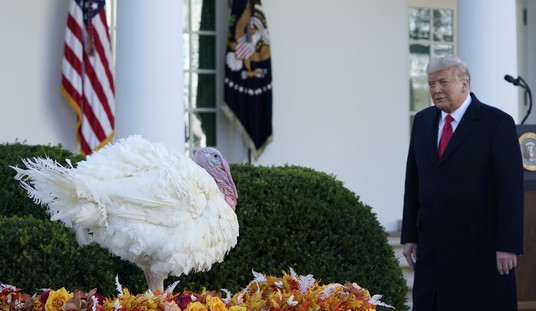Via the Daily Caller, maybe it’s time. Until recently, centrist GOPers would greet tea-party saber-rattling about going third party with a Vader-esque “nooooooooooo.” Lately, based on what I see on Twitter, the feeling seems to be more of a “hmmmmmmm.” If you believe that RINOs are no different from Democrats then there’s no reason to fear losing to Democrats repeatedly over the short- and medium-term due to a split right-wing vote. And if you believe that the tea party is destroying the Republican Party’s brand, amputating it now might be the only way to preserve the GOP as a rallying point for center-right voters. In theory, without very conservative voters in the party, some centrists who’ve been reluctantly voting Democratic lately due to fear/loathing of the right will decide it’s safe to come home to the newly RINO-esque GOP. Won’t be enough to stop Hillary, but then, that’s not the point. The whole point of the centrist/conservative brawling lately is that each side seems to see the other, not the Democrats, as the most immediate, threatening obstacle to good government in America. Hard to keep a movement together when it’s in a state like that.
So here’s conservative Sean Hannity saying maybe it’s time for a right-wing third party, and here’s centrist David Frum saying, “Yeah, maybe.”
Pragmatists want to change the GOP so that it can win elections and govern effectively. Tea party Republicans prefer to express their principles regardless of consequences, which is why the Pew survey in September found that 71% of them favored a government shutdown even though nearly 40% of them expected that shutdown to have a “major” impact on the economy…
Yet politics is a complicated business, and it’s not always true that a party is weakened by the departure of its most extreme supporters…
Right now, tea party extremism contaminates the whole Republican brand. It’s a very interesting question whether a tea party bolt from the GOP might not just liberate the party to slide back to the political center — and liberate Republicans from identification with the Sarah Palins and the Ted Cruzes who have done so much harm to their hopes over the past three election cycles.
It’s worth repeating over and over again. Add Todd Akin in Missouri and Richard Mourdock in Indiana, Sharron Angle in Nevada and Ken Buck in Colorado, Christine O’Donnell in Delaware and Joe Miller in Alaska — and you have half a dozen Senate races lost to the GOP by extremist nominations.
Simple math for both wings: If you think the RINOs/tea partiers are ultimately costing you more votes than they’re winning you, then you should consider accepting near-term losses to Democrats after a schism as the price of being able to rebrand and build a party platform that truly represents your constituency. For RINOs, that would mean mild spending cuts and very mild entitlement reform, if any; for tea partiers, it would mean more aggressive cuts and reforms. On social issues, RINOs would likely back gay marriage and amnesty; tea partiers would oppose both. You might even see foreign-policy delineations emerge, with RINOs sticking to Bush-esque hawkishness and tea partiers tilting a bit more towards the Paul “non-interventionist” position.
A key question: If it did happen, would that drag Democrats further to the center or further to the left? They’d have a chokehold on national elections with the right divided, which is precisely why some lefties would feel tempted to up their own demands of the Democratic leadership. “Do what we want,” they’d say, “or we’ll bolt like the tea partiers did and then your national advantage will be gone.” This is why, I think, centrists like Frum want to make sure there’s a RINO alternative to the tea party — if liberals did start muscling Democrats towards the left, a center-right outlet would be a natural safe harbor for centrist Democrats who are disaffected by their party’s leftward turn. On the other hand, if Democrats tacked towards the center to preserve their national chokehold over the right, that would mean (a) a somewhat more right-wing Democratic Party than we have now and (b) a lot of disaffected liberals, who might eye what the tea party did and start thinking about forming a third (or rather fourth) party of their own. In fact, one point overlooked by most people in the big Gallup poll of third-party fee-vah last week is that Democratic voters increasingly like the idea too:

Imagine the electorate split in four — the Liberal Party with 10 percent of the vote, the Democrats with 40 percent, the GOP with 30 percent, and the Tea Party with 20. Imagine trying to blog that madness every two years during the midterm campaign. Two words, my friends: Traffic goldmine.







Join the conversation as a VIP Member